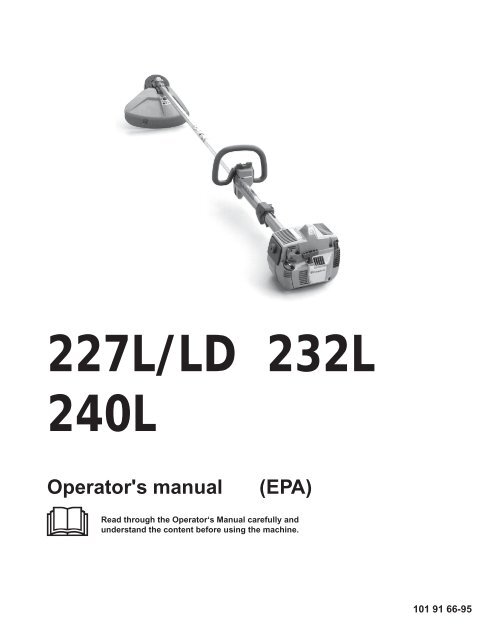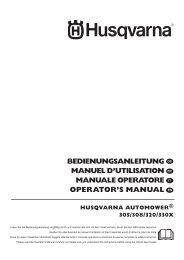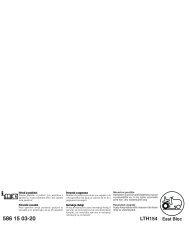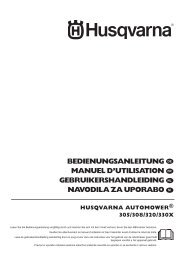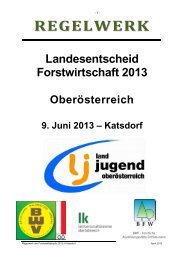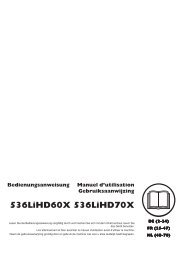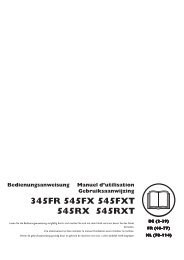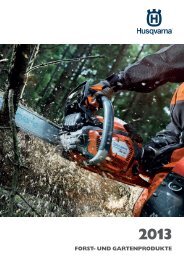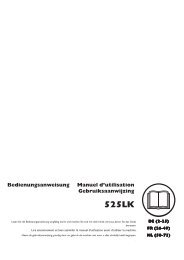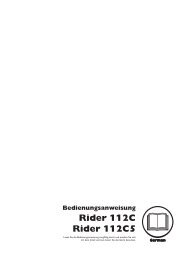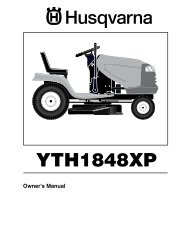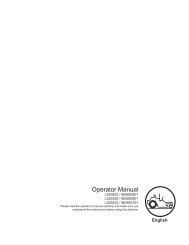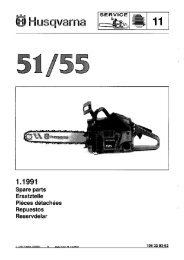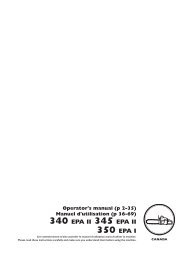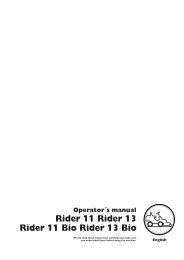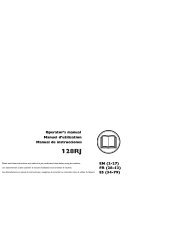OM, 227 L, 227 LD, 232 L, 240 L, 2001-11 - Husqvarna
OM, 227 L, 227 LD, 232 L, 240 L, 2001-11 - Husqvarna
OM, 227 L, 227 LD, 232 L, 240 L, 2001-11 - Husqvarna
Create successful ePaper yourself
Turn your PDF publications into a flip-book with our unique Google optimized e-Paper software.
<strong>227</strong>L/<strong>LD</strong> <strong>232</strong>L<br />
<strong>240</strong>L<br />
Operator's manual<br />
(EPA)<br />
Read through the Operator‘s Manual carefully and<br />
understand the content before using the machine.<br />
101 91 66-95
Symbols<br />
SYMBOL EXPLANATION<br />
WARNING! Clearing saws,<br />
brushcutters and trimmers can be<br />
dangerous!<br />
Careless or incorrect use can result in<br />
serious or fatal injury to the operator<br />
or others.<br />
• Always wear approved protective<br />
gloves.<br />
• Use anti-slip and stable boots.<br />
Read through the Operator‘s Manual<br />
carefully and understand the content<br />
before using the machine.<br />
Always use<br />
• A protective helmet where there is<br />
a risk of falling objects<br />
• Ear protection<br />
• Approved eye protection<br />
• Only use non-metallic, flexible<br />
cutting elements, that is trimmer<br />
head with trimmer cord.<br />
• Only intended for the trimmer<br />
head.<br />
max<br />
10000 rpm<br />
• Max. speed of output axle, rpm<br />
• This product is in accordance with<br />
applicable CE directives.<br />
Other symbols/decals on the machine refer to<br />
special certification requirements for certain<br />
markets.<br />
• Beware of thrown objects and<br />
ricochets.<br />
Checks and/or maintenance should<br />
be carried out with the engine<br />
switched off, with the stop switch in<br />
the STOP position.<br />
15 m<br />
50FT<br />
15 m<br />
50FT<br />
• The operator of the machine shall<br />
ensure, while working, that no<br />
persons or animals come closer<br />
than 15 metres.<br />
Always wear approved protective<br />
gloves.<br />
• Blade can thrust violently when<br />
coming in contact with any object.<br />
Blade thrust can cause amputation<br />
of arms or legs. Keep people and<br />
animals 50 feet away. Never use<br />
blades unless recommended<br />
handlebar, shoulder strap,<br />
attaching hardware and blade<br />
deflector are installed.<br />
Regular cleaning required.<br />
Ocular control.<br />
• Arrows which show limits for<br />
handle mounting.<br />
Approved eye protection must always<br />
be used.<br />
2 – English
CONTENTS<br />
<strong>Husqvarna</strong> AB has a policy of continuous product<br />
development and therefore reserves the right to modify the<br />
design and appearance of products without prior notice.<br />
List of contents<br />
Maintenance, replacement, or repair of the emission control<br />
devices and systems may be performed by any nonroad<br />
engine repair establishment or individual.<br />
!<br />
WARNING!<br />
Under no circumstances may the design<br />
of the machine be modified without the<br />
permission of the manufacturer. Always<br />
use genuine accessories. Non-authorized<br />
modifications and/or accessories can<br />
result in serious personal injury or the<br />
death of the operator or others.<br />
Your warranty does not cover damage or<br />
liability caused by the use of nonauthorized<br />
accessories or replacement<br />
parts.<br />
HUSQVARNA AB HUSKVARNA SWEDEN<br />
IMPORTANT ENGINE INFORMATION TWC<br />
THIS ENGINE CONFORMS TO U.S. EPA<br />
PH1<br />
FOR SMALL NON - ROAD ENGINES.<br />
REFER TO OPERATOR`S MANUAL FOR<br />
MAINTENANCE SPECIFICATIONS AND ADJUSTMENTS.<br />
This decal certifies that the product has been approved in<br />
accordance with American exhaust emissions requirements<br />
EPA PH1.<br />
SYMBOL EXPLANATION<br />
Symbols ............................................................................... 2<br />
CONTENTS<br />
List of contents .................................................................... 3<br />
SAFETY INSTRUCTIONS<br />
Personal protective equipment ............................................. 4<br />
The machine‘s safety equipment .......................................... 4<br />
Control, maintenance and service of the machine‘s safety<br />
equipment ...................................................................... 6<br />
Cutting equipment .............................................................. 7<br />
General safety instructions ................................................... 8<br />
General working instructions ............................................... 9<br />
Basic working techniques ..................................................... 9<br />
WHAT IS WHAT?<br />
What is what on the trimmer?............................................ <strong>11</strong><br />
ASSEMBLY<br />
Assembling the loop handlebar .......................................... 12<br />
Assembly of the trimmer head ........................................... 12<br />
Assembling the spray guard and trimmer head<br />
Superauto II ................................................................. 12<br />
Assembling other guards and cutting equipment ................ 13<br />
Assembling and dismantling the two-part shaft<br />
(<strong>227</strong><strong>LD</strong>)....................................................................... 13<br />
FUEL HANDLING<br />
Fuel mixture ...................................................................... 14<br />
Fuelling.............................................................................. 14<br />
START AND STOP<br />
Control before starting ....................................................... 15<br />
Start and stop..................................................................... 15<br />
MAINTENANCE<br />
Carburetor ......................................................................... 16<br />
Muffler .............................................................................. 18<br />
Cooling system .................................................................. 18<br />
Spark plug.......................................................................... 18<br />
Air filter ............................................................................. 19<br />
Angle gear .......................................................................... 19<br />
Two-part shaft.................................................................... 19<br />
Maintenance schedule ........................................................ 19<br />
TECHNICAL DATA<br />
<strong>227</strong>L/<strong>LD</strong> ........................................................................... 20<br />
<strong>232</strong>L .................................................................................. 20<br />
<strong>240</strong>L .................................................................................. 20<br />
EMISSION CONTROL WARRANTY STATEMENT<br />
Your warranty rights and obligations .................................. 21<br />
English – 3
SAFETY INSTRUCTIONS<br />
Personal protective equipment<br />
MPORTANT INFORMATION<br />
• A clearing saw, brushcutter or trimmer used<br />
incorrectly or carelessly can become a dangerous<br />
tool, that can cause serious or fatal injury to the<br />
operator or others. It is extremely important that<br />
you read and understand the content of this<br />
manual.<br />
• When using a trimmer, personal protective<br />
equipment approved by the appropriate<br />
authorities must be used. Personal protective<br />
equipment does not eliminate the risk of<br />
accidents, however, it can reduce the effects of an<br />
injury in the event of an accident. Ask your dealer<br />
for help when choosing protective equipment.<br />
!WARNING!<br />
Remove your hearing protection as soon as<br />
you stop the engine, so that you can hear<br />
any noises or warning signals.<br />
GLOVES<br />
Gloves should be worn<br />
when necessary, e.g., when<br />
assembling cutting<br />
equipment.<br />
EAR PROTECTION<br />
Ear protection offering<br />
sufficient dampening effect<br />
should be used.<br />
EYE PROTECTION<br />
Blows from branches or<br />
objects thrown by the<br />
rotating cutting equipment<br />
can damage the eyes.<br />
BOOTS<br />
Use anti-slip and stable<br />
boots.<br />
CLOTHING<br />
Wear clothes made of a<br />
strong fabric and avoid<br />
loose clothing that can<br />
catch on shrubs and<br />
branches. Always wear<br />
heavy, long pants. Do not<br />
wear jewelry, short pants,<br />
sandals or go barefoot.<br />
Secure hair so it is above<br />
shoulder level.<br />
FIRST AID KIT<br />
A first aid kit should be<br />
carried by operators of<br />
clearing saws, brushcutters<br />
or trimmers.<br />
The machine‘s safety equipment<br />
This section describes the machine‘s safety equipment, its<br />
function and how checks and maintenance are carried out to<br />
ensure that it operates correctly. (See the chapter “What is<br />
what“ to locate where this equipment is positioned on your<br />
machine.)<br />
!<br />
WARNING!<br />
Never use a machine with defective safety<br />
equipment. Follow the control,<br />
maintenance and service instructions<br />
described in this section.<br />
1. Throttle trigger<br />
lock<br />
The throttle trigger lock is<br />
designed to prevent the<br />
throttle from accidentally<br />
being engaged. When the<br />
trigger lock (A) is pressed<br />
into the handle (= when you<br />
hold the handle) the throttle<br />
(B) is released. When the<br />
grip on the handle is<br />
released the throttle and the<br />
throttle trigger lock return<br />
to their original positions.<br />
This takes place via two<br />
independent return spring<br />
systems. This means that the<br />
throttle is automatically<br />
locked in its “idling“<br />
position.<br />
2. Stop switch<br />
The stop switch should be<br />
used to stop the engine.<br />
3. Cutting<br />
attachment guard<br />
This guard is intended to<br />
prevent objects from being<br />
thrown towards the<br />
operator and to protect the<br />
operator from<br />
unintentionel contact with<br />
the cutting attachment.<br />
!<br />
A<br />
B<br />
A<br />
B<br />
"<br />
WARNING!<br />
Under no circumstances may the cutting<br />
equipment be used without an approved<br />
guard fitted. See the chapter “Technical<br />
data”. If the wrong guard or a defective<br />
guard is fitted this can cause serious<br />
personal injury.<br />
4 – English
SAFETY INSTRUCTIONS<br />
4. Vibration<br />
damping system<br />
Your machine is equipped<br />
with a vibration damping<br />
system, which is designed<br />
to give as vibration-free<br />
and comfortable use as<br />
possible.<br />
Use of incorrectly wound<br />
cord or incorrect cutting<br />
equipment increases the<br />
level of vibration.<br />
The machine’s vibration<br />
damping system reduces<br />
the transfer of vibrations<br />
between the engine unit/<br />
cutting equipment and the<br />
machine’s handle unit.<br />
5. Muffler<br />
The muffler is designed to<br />
give the lowest possible noise<br />
level and to direct the engine‘s<br />
exhaust fumes away from the<br />
operator. Muffler fitted with<br />
catalytic converter is also<br />
designed to reduce harmful<br />
exhaust components.<br />
In countries that have a warm<br />
and dry climate the risk of fire<br />
is obvious. We have therefore<br />
fitted certain mufflers with a<br />
spark arrest screen. Make sure<br />
that your muffler is fitted<br />
with this kind of screen.<br />
It is extremely important that<br />
the instructions for checking,<br />
maintaining and servicing the<br />
muffler are followed. (see the<br />
section “Control, maintenance<br />
and service of the machine‘s<br />
safety equipment“).<br />
!<br />
WARNING!<br />
Mufflers fitted with catalytic converters<br />
become extremely hot during use and<br />
after stopping. This also applies at idling<br />
speeds. Contact can result in burns to<br />
the skin. Be observant to the risk of fire!<br />
!WARNING!<br />
Over exposure to vibrations can result in<br />
blood-vessel or nerve injury to persons<br />
suffering with blood circulation problems.<br />
Seek medical attention if you experience<br />
physical symptoms that can be related to<br />
over exposure to vibrations. Examples of<br />
such symptoms are “numbness“, lack of<br />
feeling, “tickling“, “pricking“, “pain“ lack of<br />
or a reduction in normal strength, changes<br />
in the colour of the skin or its surfaces.<br />
These symptoms normally appear in the<br />
fingers, hands or wrists.<br />
!<br />
6. Cutting<br />
equipment<br />
The trimmer head is<br />
intended for trimming<br />
grass.<br />
7. Locking nut<br />
WARNING!<br />
Bear in mind that exhaust fumes:<br />
• contain carbon monoxide, which can<br />
cause carbon monoxide poisoning.<br />
Therefore never start or run the machine<br />
indoors.<br />
• are hot and can contain sparks that can<br />
cause fires. Never start the machine<br />
indoors or close to inflammable material.<br />
A locking nut is used to<br />
secure some types of cutting<br />
equipment on the output<br />
shaft.<br />
English – 5
SAFETY INSTRUCTIONS<br />
Control, maintenance and service of<br />
the machine‘s safety equipment<br />
IMPORTANT INFORMATION<br />
• All service and repairs to the machine require<br />
special training.<br />
• This applies especially to the machine‘s safety<br />
equipment. If the machine does not meet any of<br />
the controls listed below you should contact your<br />
service workshop.<br />
• The purchase of one of our products<br />
guarantees that professional repair and servicing<br />
will be carried out on it. If the point of purchase is<br />
not one of our servicing dealers, please ask for<br />
details of the closest service workshop.<br />
1. Throttle trigger<br />
lock<br />
• Check that the throttle is<br />
locked in the “idling<br />
position“ when the<br />
throttle trigger lock is in<br />
its original position.<br />
• Press in the throttle<br />
trigger lock and make sure<br />
it returns to its original<br />
position when released.<br />
3. Cutting<br />
attachment guard<br />
• Ensure that the spray<br />
guard is undamaged and<br />
is not cracked.<br />
• Replace the guard if it<br />
has been exposed to<br />
impact or is cracked.<br />
• Always use the prescribed<br />
blade an guard<br />
combination, see chapter<br />
"Technical data".<br />
4. Vibration<br />
damping system<br />
• Check the vibration<br />
damping element<br />
regularly for material<br />
cracks and distortion.<br />
• Check that the vibration<br />
damping element is<br />
undamaged and securely<br />
attached.<br />
• Ensure that the throttle<br />
and throttle trigger lock<br />
move easily and that their<br />
return spring systems<br />
function.<br />
• See section "Start". Start<br />
the machine and apply<br />
full throttle. Release the<br />
throttle and check that the<br />
cutting equipment stops<br />
and remains at a standstill.<br />
If the cutting equipment<br />
rotates with the throttle in<br />
the idling position then<br />
the carburettor‘s idling<br />
setting must be checked.<br />
See chapter<br />
“Maintenance“.<br />
2. Stop switch<br />
• Start the engine and make<br />
sure that the engine stops<br />
when the stop switch is<br />
moved to the stop<br />
position.<br />
#<br />
5. Muffler<br />
1.Never use a machine that<br />
has a defective muffler.<br />
2.Check regularly that the<br />
muffler is secure.<br />
3.If your muffler is fitted<br />
with a spark arrest screen<br />
then it should be cleaned<br />
regularly. A blocked<br />
screen leads to the engine<br />
overheating with serious<br />
damage as a result. Never<br />
use a muffler with a<br />
defective spark arrest<br />
screen.<br />
6 – English
SAFETY INSTRUCTIONS<br />
6. Cutting equipment<br />
The section describes how through correct maintenance and<br />
through using the right type of cutting equipment you can:<br />
• Obtain maximum clearing capacity.<br />
• Increase the service life of the cutting equipment.<br />
Two basic rules:<br />
1)Only use the cutting<br />
and guard equipment<br />
we recommend! See<br />
chapter “Technical<br />
data“.<br />
2)Check the cutting<br />
equipment with regard<br />
to damage and crack<br />
formation. Damaged<br />
cutting equipment<br />
should always be<br />
replaced.<br />
7. Locking nut<br />
• Protect your hand from<br />
injury when assembling,<br />
use the blade guard as<br />
protection when tightening<br />
with a socket spanner.<br />
Tighten the nut by turning<br />
against the direction of<br />
rotation. Loosen the nut by<br />
turning in the direction of<br />
rotation. (NOTE! the nut<br />
has a left-hand thread).<br />
• Tighten the nut using a<br />
socket spanner, 35 - 50<br />
Nm (3.5 - 5 kpm).<br />
NOTE!<br />
The locking nut‘s nylon lock must not be so worn that it can<br />
be turned by hand. The lock shall hold at least 1.5 Nm. The<br />
nut should be replaced after it has been put on approx. 10<br />
times.<br />
!<br />
WARNING!<br />
Never use a machine with defective<br />
safety equipment. The safety equipment<br />
should be maintained as described in this<br />
section. If your machine does not meet<br />
any of these controls you should contact<br />
your service workshop.<br />
Cutting equipment<br />
IMPORTANT INFORMATION<br />
The section describes how through correct<br />
maintenance and through using the right type of<br />
cutting equipment you can obtain maximum<br />
clearing capacity and increase the service life of<br />
the cutting equipment.<br />
• Only use the cutting and guard equipment we<br />
recommend! See chapter “Technical data“.<br />
Trimmer head<br />
• Only use a trimmer head<br />
and trimmer cord that is<br />
recommended. These<br />
have been tested by the<br />
manufacturer to suit a<br />
particular engine size.<br />
This is especially<br />
important when a fully<br />
automatic trimmer head<br />
is used. Only use the<br />
cutting equipment we<br />
recommend! See chapter<br />
“Technical data“.<br />
• Generally smaller machines require a small trimmer head<br />
and vice versa. This is because when clearing using a cord<br />
the engine must throw out the cord radially from the<br />
trimmer head and also meet resistance from the grass being<br />
cleared.<br />
• The length of the cord is also important. A longer cord<br />
requires greater engine power than a shorter cord of the<br />
same diameter.<br />
• Make sure the knife positioned on the trimmer guard is<br />
intact. This is used to cut the cord to the correct length.<br />
• To increase the life of the cord it can be soaked in water for<br />
a few days. This will make the line tougher and it will keep<br />
longer.<br />
IMPORTANT INFORMATION<br />
Always ensure the trimmer cord is wound tightly<br />
and evenly around the drum, otherwise harmful<br />
vibrations will occur.<br />
!<br />
WARNING!<br />
Always stop the engine before starting<br />
work on any part of the cutting equipment.<br />
This continues to rotate even after the<br />
throttle has been released. Ensure that the<br />
cutting equipment has stopped completely<br />
and remove the cable from the spark plug<br />
before you start to work on it.<br />
English – 7
SAFETY INSTRUCTIONS<br />
General safety instructions<br />
IMPORTANT INFORMATION<br />
• The machine is only designed for trimming grass.<br />
• The only accessories to be used with the engine<br />
unit as a drive source are the cutting units we<br />
recommend in the chapter “Technical data“.<br />
• Never use the machine if you are tired, if you<br />
have consumed alcohol, or if you are taking<br />
medicines that can affect your sight, your<br />
judgement or the control of your body.<br />
• Use personal protective equipment. See the<br />
section “Personal protective equipment“.<br />
• Never use a machine that has been modified so<br />
that it no longer corresponds with the original<br />
design.<br />
• Never use a machine that is faulty. Follow the<br />
maintenance, control and service instructions in<br />
this Operator‘s Manual. Some maintenance and<br />
service actions should be carried out by trained<br />
and qualified specialists. See the chapter<br />
“Maintenance“.<br />
• All covers and guards must be fitted before<br />
starting the machine. Check that the spark plug<br />
cap and HT lead are not damaged, otherwise you<br />
could get an electric shock.<br />
• The machine operator shall ensure, while<br />
working, that no persons or animals come closer<br />
than 15 metres (50 feet). When several operators<br />
are working in the same area the safety distance<br />
should be at least double tree length, however, at<br />
least 15 metres (50 feet).<br />
WARNING!<br />
Faulty cutting equipment increases the risk<br />
!of accidents.<br />
Start<br />
Fuel safety<br />
• Always use a fuel container<br />
with an anti-spill valve.<br />
• Never fill the machine<br />
while the engine is<br />
running. Always stop the<br />
engine and let it cool for a<br />
few minutes before<br />
refuelling.<br />
• Provide good ventilation<br />
when filling or mixing fuel<br />
(petrol and 2-stroke oil).<br />
• Move the machine at least<br />
3 m from the filling<br />
position before starting.<br />
• Never start the machine:<br />
a) If you have spilt fuel on it.<br />
Wipe up all spillage.<br />
b)If you have spilt fuel on<br />
yourself or your clothes.<br />
Change your clothes.<br />
c) If there is a fuel leak.<br />
Make regular checks for<br />
leakage from the fuel cap<br />
and the fuel supply pipes.<br />
Transport and storage<br />
Min. 3 m<br />
(10 ft)<br />
!WARNING!<br />
When the engine is started with the choke<br />
in either the choke or start throttle positions<br />
the cutting equipment starts to rotate<br />
immediately.<br />
• The complete clutch cover with shaft must be fitted before<br />
the machine is started, otherwise the clutch can become<br />
loose and cause personal injury.<br />
• Never start the machine indoors. Bear in mind the dangers<br />
of inhaling the engine‘s exhaust fumes.<br />
• Observe your surroundings and make sure that there is no<br />
risk of people or animals coming into contact with the<br />
cutting equipment.<br />
• Place the machine on the<br />
ground, ensure the cutting<br />
equipment runs free of<br />
twigs and stones. Push the<br />
machine body towards the<br />
ground using your left<br />
hand. (NOTE! Not with<br />
your foot). Grip the starter<br />
handle with your right<br />
hand and pull the<br />
startercord.<br />
• Store and transport the machine and fuel so that any leakage<br />
or fumes do not risk coming into contact with sparks or<br />
naked flames. For example, electric machines, electric<br />
motors, electrical switches/power switches, heaters or the<br />
like.<br />
• When storing and transporting fuel approved containers<br />
intended for this purpose must be used.<br />
• When storing the machine for long periods the fuel tank<br />
must be emptied. Contact your local petrol station to find<br />
out how to dispose of excess fuel.<br />
!<br />
WARNING!<br />
Exercise great care when handling fuel.<br />
Bear in mind the risk of fire, explosions and<br />
inhaling fumes.<br />
8 – English
SAFETY INSTRUCTIONS<br />
General working instructions<br />
IMPORTANT INFORMATION<br />
• This section takes up the basic safety<br />
precautions for working with the trimmer.<br />
• If you encounter a situation where you are<br />
uncertain how to proceed you should ask an<br />
expert. Contact your dealer or your service<br />
workshop.<br />
• Avoid all usage which you consider to be<br />
beyond your capability.<br />
Basic safety precautions<br />
1.Observe your surroundings:<br />
• To ensure that people, animals or other things cannot affect<br />
your control of the machine.<br />
• To ensure that the above mentioned do not come into<br />
contact with the cutting equipment or objects that can be<br />
thrown by the cutting equipment.<br />
• NOTE! Never use a machine without the possibility of<br />
calling for help in the event of an accident.<br />
2.Avoid usage in<br />
unfavourable weather<br />
conditions. For example,<br />
thick fog, heavy rain,<br />
strong winds or extreme<br />
cold, etc. To work in bad<br />
weather conditions is<br />
tiring and can create<br />
dangerous circumstances,<br />
e.g. slippery surfaces.<br />
3.Make sure you can walk<br />
and stand safely. Look out<br />
for any obstacles with<br />
unexpected movement<br />
(roots, stones, branches,<br />
pits, ditches, etc.). Take<br />
great care when working<br />
on sloping ground.<br />
Basic working techniques<br />
• Always drop to idling speed after each working operation.<br />
Longer periods running at full throttle without loading the<br />
engine (that is without resistance, which the engine feels<br />
from the cutting equipment when trimming) can lead to<br />
serious engine damage.<br />
!<br />
WARNING!<br />
Sometimes branches, grass or wood can<br />
get caught between the guard and cutting<br />
equipment. Always stop the engine when<br />
cleaning.<br />
Grass trimming<br />
using the trimmer<br />
head and plastic<br />
knifes<br />
• Hold the trimmer head<br />
just above the ground at<br />
an angle. It is the end of<br />
the cord that carries out<br />
the work. Let the cord<br />
work at its own pace. Do<br />
not press the cord into the<br />
area to be cut.<br />
• The cord can easily<br />
remove grass and weeds up<br />
against walls, fences, trees<br />
and borders, however, it<br />
can also damage sensitive<br />
bark on trees and bushes<br />
and damage fence posts.<br />
• Reduce the risk of<br />
damaging plants by<br />
shortening the cord to 10-<br />
12 cm and reducing the<br />
engine speed.<br />
4.The engine should be switched off before moving. When<br />
moving over longer distances and transporting the transport<br />
guard should be used.<br />
5.Never put the machine down with the engine running unless<br />
you have good sight of it.<br />
6.. Do not over-reach<br />
7.Keep Cutting attachment below waist level.<br />
English – 9
SAFETY INSTRUCTIONS<br />
Clearing<br />
• The clearing technique<br />
removes all unwanted<br />
vegetation. Keep the<br />
trimmer head just above<br />
the ground and tilt it.<br />
Let the end of the cord<br />
strike the ground around<br />
trees, posts, statues and<br />
the like. NOTE! This<br />
technique increases the<br />
wear on the cord.<br />
• The cord wears quicker<br />
and must be fed forward<br />
more often when<br />
working against stones,<br />
brick, concrete, metal<br />
fences, etc. than when<br />
coming into contact<br />
with trees and wooden<br />
fences.<br />
• When trimming and<br />
clearing you should use<br />
less than full throttle so<br />
that the cord lasts longer<br />
and to reduce the wear<br />
on the trimmer head.<br />
Trimming<br />
• The trimmer is ideal to<br />
cut grass that is difficult<br />
to reach using a normal<br />
lawn mower. Keep the<br />
cord parallel to the<br />
ground when cutting.<br />
Avoid pressing the<br />
trimmer head against the<br />
ground as this can ruin<br />
the lawn and damage the<br />
tool.<br />
• Do not allow the<br />
trimmer head to<br />
constantly come into<br />
contact with the ground<br />
during normal cutting<br />
procedures. Constant<br />
contact can cause damage<br />
and wear to the trimmer<br />
head.<br />
Sweeping<br />
• The rotating cord‘s<br />
fanning effect can be<br />
used for quick and easy<br />
cleaning. Hold the cord<br />
parallel to and above the<br />
area to be swept and<br />
move the trimmer from<br />
side to side.<br />
• When cutting and<br />
sweeping you should use<br />
full throttle to obtain the<br />
best results.<br />
!<br />
WARNING!<br />
The bevel gear unit can get hot during use<br />
and may remain so for a while afterwards.<br />
There is a risk of slight burns if you touch it.<br />
!<br />
WARNING!<br />
Warning for thrown objects. Always wear<br />
protective glasses. Never lean over the<br />
guard. Stones, rubbish, etc. can be thrown<br />
up into the eyes causing blindness or<br />
serious injury.<br />
Keep unauthorised persons at a distance.<br />
Children, animals, onlookers and helpers<br />
should be kept outside the safety zone of<br />
15 m (50 feet). Stop the machine<br />
immediately if anyone approaches.<br />
10 – English
WHAT IS WHAT?<br />
¢<br />
=<br />
27<br />
25<br />
¥<br />
26<br />
What is what on the trimmer?<br />
1. Trimmer head<br />
2. Grease filler cap<br />
3. Angle gear<br />
4. Spray guard<br />
5. Shaft<br />
6. Loop handlebar<br />
7. Throttle<br />
8. Stop switch<br />
9. Throttle trigger lock<br />
10. Suspension for harness<br />
<strong>11</strong>. Cylinder cover<br />
12. Starter handle<br />
13. Fuel tank<br />
14. Choke<br />
15. Air purge<br />
16. Air filter cover<br />
17. Clutch cover<br />
18. Handlebar adjustment<br />
19. Locking nut<br />
20. Support flange<br />
21. Drive disc<br />
22 Shaft coupling<br />
23. Socket spanner<br />
24. Operator‘s Manual<br />
25. Harness<br />
26. Allen key<br />
27. Locking pin<br />
English – <strong>11</strong>
ASSEMBLY<br />
Assembling the loop handlebar<br />
• Unscrew the handle and<br />
plastic cover from the<br />
handlebar bracket.<br />
• Place the loop handlebar<br />
with the handlebar holder<br />
on the handlebar bracket.<br />
Fit the handle and plastic<br />
cover. Do not tighten too<br />
tight.<br />
Assembling the spray guard and<br />
trimmer head Superauto II<br />
• Fit the guard (A) intended<br />
for use with the trimmer<br />
head. Secure using the 4<br />
bolts (L) and the support<br />
plate (M) as set out in the<br />
diagram.<br />
• Fit the drive disc (B) on the<br />
output axle.<br />
J<br />
K<br />
I<br />
• Put on the harness and<br />
hang the trimmer in the<br />
suspension hook. Now<br />
finely adjust so that the<br />
trimmer gives a<br />
comfortable working<br />
position when it‘s<br />
attached to the harness.<br />
Tighten the handle.<br />
• Turn the blade axle until<br />
one of the holes in the<br />
drive disc aligns with the<br />
hole in the gear housing.<br />
• Insert the locking pin (C)<br />
in the hole so that the axle<br />
is locked.<br />
• The trimmer head must be<br />
split to be fitted (see the<br />
diagram). Proceed as<br />
follows:<br />
L<br />
G<br />
F<br />
I<br />
M<br />
K<br />
B<br />
C<br />
Assembly of the trimmer head<br />
• Insert your finger into the<br />
centre hole of the cover (I)<br />
at the same time as you<br />
hold the cover with your<br />
other fingers. Press the two<br />
catches (J) that extend from<br />
the cut-out on the bottom<br />
section (K) using the<br />
thumb and index finger of<br />
your other hand. Press<br />
apart the trimmer head<br />
using the fingers on the<br />
cover.<br />
A<br />
It is extremely important<br />
that the disc drive’s/support<br />
flange’s guide engages<br />
correctly in the cutting<br />
equipment’s centre hole<br />
when assembling the cutting<br />
equipment. Cutting<br />
equipment assembled<br />
incorrectly can result in<br />
serious and/or fatal personal<br />
injury.<br />
!<br />
WARNING!<br />
Under no circumstances may the cutting<br />
equipment be used without an approved<br />
guard fitted. See the chapter “Technical<br />
data”. If the wrong guard or a defective<br />
guard is fitted this can cause serious<br />
personal injury.<br />
• Place the cover (I) and the<br />
support flange (F) on the<br />
output axle.<br />
• Fit the nut (G). The<br />
tightening torque of the<br />
nut is 35-50 Nm (3,5-5<br />
kpm). Use the socket<br />
spanner in the tool kit.<br />
Hold the handle of the<br />
spanner as close to the<br />
trimmer guard as possible. The nut is tightened when the<br />
spanner is turned against the direction of rotation (left-hand<br />
thread).<br />
• Fit the trimmer head‘s bottom section (K) on the cover (I)<br />
by pressing the two sections together with the cut-outs on<br />
the bottom section aligned with the catches on the cover.<br />
• To dismantle follow the instructions in the reverse order.<br />
12 – English
ASSEMBLY<br />
Assembling other guards and<br />
cutting equipment<br />
Assembling and dismantling the<br />
two-part shaft (<strong>227</strong><strong>LD</strong>)<br />
• Fit the guard (A)<br />
intended for use with<br />
the trimmer head.<br />
Secure using four bolts<br />
(L) and the support plate<br />
(M) as shown in the<br />
diagram.<br />
• Fit the disc drive (B) on<br />
the output axle.<br />
M<br />
A<br />
L<br />
B<br />
C<br />
Assembling:<br />
• Make sure the handle is<br />
loose.<br />
• Guide the cut-out on the<br />
lower section of the shaft<br />
into the coupling‘s<br />
locking plate on the<br />
upper section of the<br />
shaft. The sections are<br />
then locked together.<br />
• Turn the blade axle until<br />
one of the disc drive’s<br />
holes aligns with the<br />
corresponding hole in<br />
the gear housing.<br />
• Insert the locking pin<br />
(C) into the hole to lock<br />
the axle.<br />
• Screw on the trimmer<br />
head (H) in the<br />
direction of rotation.<br />
H<br />
• Tighten the handle.<br />
Dismantling<br />
• Undo the handle (at least<br />
three turns).<br />
• Press the handle towards<br />
the coupling.<br />
• Carefully twist the lower<br />
section out of the lock.<br />
• Hold both parts of the<br />
shaft and pull out the<br />
lower section from the<br />
coupling.<br />
• Dismantling takes place<br />
in the reverse order.<br />
English – 13
FUEL HANDLING<br />
Fuel mixture<br />
NOTE!<br />
The machine is fitted with a two-stroke engine and must<br />
always be run on a mixture of gasoline and two-stroke oil. It is<br />
important to measure the quantity of oil accurately, to ensure<br />
the correct mixture ratio. Small discrepancies in the amount of<br />
oil have a great bearing on the proportions of the fuel mixture<br />
when mixing small amounts of fuel.<br />
!WARNING!<br />
Always provide good ventilation when<br />
handling fuel.<br />
Gasoline<br />
NOTE!<br />
Always use high grade<br />
unleaded oil mixed gasoline<br />
(minimum 87 RON).<br />
Leaded fuel will destroy the<br />
catalytic converter and it<br />
will no longer serve its<br />
purpose.<br />
• This engine is certified to<br />
operate on unleaded<br />
gasoline.<br />
• The lowest recommended<br />
octane rating is 87. If you<br />
run the engine on lower<br />
octane rating than 87 socalled<br />
“knocking“ can<br />
occur. This leads to an<br />
increased engine<br />
temperature, which can<br />
result in a serious engine<br />
breakdown.<br />
• When working at<br />
continuous high revs a<br />
higher octane rating is<br />
recommended.<br />
Two-stroke oil<br />
• For the best results use<br />
HUSQVARNA twostroke<br />
oil, which has been<br />
specially developed for<br />
clearing saws and chain<br />
saws.<br />
Mixing ratio 1:50 (2%).<br />
• Never use two-stroke oil<br />
intended for water cooled<br />
outboard motors, so-called<br />
outboard motor oil.<br />
• Never use oil intended of<br />
four-stroke engines.<br />
Mixture<br />
• Always mix gasoline and oil in a clean container intended<br />
for fuel.<br />
• Always start by filling half the quantity of gasoline required.<br />
Then add the entire oil quantity. Mix (shake) the fuel<br />
mixture. Fill the remaining quantity of gasoline.<br />
• Mix (shake) the fuel mixture carefully before filling in the<br />
machine‘s fuel tank.<br />
• Do not mix more than max. one month’s supply of fuel.<br />
• If the machine is not used for a long period of time, the fuel<br />
tank should be emptied and cleaned.<br />
• This engine is certified to operate on unleaded gasoline.<br />
!<br />
WARNING!<br />
The catalytic converter muffler gets very hot<br />
during and after use. This also applies<br />
during idling. Be aware of the fire hazard,<br />
especially when handling the saw near<br />
flammable substances or vapours.<br />
Fuelling<br />
!<br />
• Clean around the fuel<br />
cap. Contamination in<br />
the tank can disrupt<br />
operations.<br />
• Ensure that the fuel is<br />
well mixed by shaking the<br />
container before filling<br />
the tank.<br />
Gasoline<br />
Lit.<br />
5<br />
10<br />
15<br />
20<br />
US<br />
gallon<br />
1<br />
2 1/2<br />
5<br />
WARNING!<br />
The following precautions reduce the risk of<br />
fire:<br />
Do not smoke or place any sources of heat<br />
in the vicinity of the fuel. Never refuel when<br />
the engine is running. Always stop the<br />
engine and let it cool for a few minutes<br />
before refuelling. Open the fuel cap slowly<br />
when fuelling so that any over pressure is<br />
released slowly. Tighten the fuel cap<br />
carefully after refuelling. Always move the<br />
machine from the fuelling place before<br />
starting.<br />
Oil<br />
2%(1:50)<br />
Lit.<br />
0,10<br />
0,20<br />
0,30<br />
0,40<br />
US<br />
fl. oz.<br />
2 1/2<br />
6 1/2<br />
12 7/8<br />
Min. 3 m<br />
(10 ft)<br />
14 – English
START AND STOP<br />
Control before starting<br />
For reasons of safety follow<br />
these recommendations!<br />
• Check that the support<br />
flange is not cracked due to<br />
fatigue or due to being<br />
tightened too much.<br />
Discard the support flange<br />
if it is cracked.<br />
• Ensure the locking nut has<br />
not lost its captive force.<br />
The nut lock should have a<br />
locking force of at least 1.5<br />
Nm. The tightening<br />
torque of the locking nut<br />
should be 35-50 Nm.<br />
• Check that the trimmer<br />
head and spray guard are<br />
not damaged or cracked.<br />
Replace the trimmer head<br />
or spray guard if they are<br />
exposed to impact or are<br />
cracked.<br />
• Never use the machine<br />
without a guard or spray<br />
guard nor with a defective<br />
guard.<br />
Start and stop<br />
!<br />
WARNING!<br />
The complete clutch cover with shaft must<br />
be fitted before the machine is started,<br />
otherwise the clutch can become loose<br />
and cause personal injury.<br />
Always move the machine from the filling<br />
area before starting. Place the machine on<br />
a flat surface. Ensure the cutting<br />
equipment cannot come into contact with<br />
any object. Make sure no unauthorised<br />
persons are in the working area,<br />
otherwise there is a risk of serious<br />
personal injury. The safety distance is 15<br />
metres.<br />
Cold engine<br />
IGNITION:<br />
Set the stop switch to the<br />
start position.<br />
CHOKE:<br />
Set the choke control in the<br />
choke position.<br />
AIR PURGE:<br />
Press the air purge<br />
diaphragm repeatedly until<br />
fuel begins to fill the<br />
diaphragm. The diaphragm<br />
need not be completely<br />
filled.<br />
Warm engine<br />
Use the same starting<br />
procedure as for the cold<br />
engine, but do not set the<br />
choke control in the choke<br />
position. The start throttle<br />
position is obtained by<br />
setting the choke control in<br />
the choke position and then<br />
returning it to its original<br />
position.<br />
Stop<br />
The engine is stopped by<br />
switching off the ignition.<br />
!<br />
equipment<br />
WARNING!<br />
When the engine is started with the choke<br />
in the choke or start position the cutting<br />
starts to rotate immediately.<br />
Start<br />
Press the machine body<br />
against the ground using<br />
your left hand (NOTE! Not<br />
your foot). Grip the starter<br />
handle, slowly pull out the<br />
cord with your right hand<br />
until you feel some resistance<br />
(the starter pawls grip), now<br />
quickly and powerfully pull<br />
the cord.<br />
Reset the choke control as<br />
soon as the engine fires and<br />
repeat until the engine starts.<br />
When the engine starts<br />
quickly apply full throttle<br />
and the start throttle will<br />
automatically disengage.<br />
NOTE! Do not pull the<br />
starter cord out completely<br />
and do not release the starter<br />
cord from the fully extended<br />
position. This can damage<br />
the machine.<br />
English – 15
MAINTENANCE<br />
Carburetor<br />
Your <strong>Husqvarna</strong> product has been designed and<br />
manufactured to specifications that reduce harmful<br />
emissions.<br />
After your unit has been run 8-10 tanks of fuel the engine<br />
has broken in. To ensure that your unit is at peak<br />
performance and producing the least amount of harmful<br />
emissions after break in, have your authorized servicing<br />
dealer, who has a revolution counter at his disposal, to adjust<br />
your carburetor for optimum operating conditions.<br />
!<br />
WARNING!<br />
The complete clutch cover with shaft<br />
must be fitted before the machine is<br />
started, otherwise the clutch can become<br />
loose and cause personal injury.<br />
Operation<br />
• The carburetor governs<br />
the engine‘s speed via the<br />
throttle. Air/fuel is mixed<br />
in the carburetor. The<br />
air/fuel mixture is<br />
adjustable. To take<br />
advantage of the engine‘s<br />
optimal output the<br />
adjustment must be<br />
correct.<br />
• The setting of the<br />
carburetor means that the<br />
engine is adapted to local<br />
conditions, for example,<br />
the climate, altitude,<br />
gasoline and the type of<br />
2-stroke oil.<br />
• The carburetor is<br />
equipped with three<br />
adjustment possibilities:<br />
L = Low speed needle<br />
H = High speed needle<br />
T = Idle speed adjuster<br />
screw<br />
• The fuel quantity in relation to the air flow permitted by the<br />
throttle opening is adjusted using the L and H-needles.<br />
Turning the needles clockwise gives a leaner fuel mixture<br />
(less fuel) and turning them anti-clockwise gives a richer fuel<br />
mixture (more fuel). A leaner mixture gives high revs while a<br />
richer mixture give less revs.<br />
• The T-screw regulates the position of the throttle while the<br />
engine is idling. Turning the screw clockwise gives a higher<br />
idling speed while turning it anti-clockwise gives a lower<br />
idling speed.<br />
Basic setting<br />
• The carburetor is set to its basic setting when test run at the<br />
factory. The basic setting should be kept during the<br />
machine‘s first working hours. Thereafter the carburetor<br />
should be finely adjusted. Fine adjustment should be carried<br />
out by a skilled technician.<br />
NOTE! If the cutting attachment rotates/moves while the<br />
engine is idling the T-screw should be turned anti-clockwise<br />
until the cutting attachment stops.<br />
Rec. idling speed 2 700 rpm.<br />
Recommended max. speed: See ”Technical Data”.<br />
!<br />
WARNING!<br />
If the idling speed cannot be adjusted so<br />
that the cutting attachment stops,<br />
contact your service workshop. Do not<br />
use the machine until it has been<br />
correctly adjusted or repaired.<br />
Fine adjustment<br />
• When the machine has been ”run-in” the carburetor should<br />
be finely adjusted. The fine adjustment should be carried<br />
out by qualified person. First adjust the L-jet, then the<br />
idling screw T and then the H-jet.<br />
Conditions<br />
• Before any adjustments are made the airfilter should be clean<br />
and the airfilter cover fitted. Adjusting the carburetor while<br />
a dirty airfilter is in use will result in a leaner mixture when<br />
the filter is finally cleaned. This can give rise to serious<br />
engine damage.<br />
• Carefully turn the L and H needle to the mid point between<br />
fully turned in and fully turned out..<br />
• Do not attempt to adjust the needles beyond the stops as<br />
damage can occur.<br />
• Now start the machine according to the starting instructions<br />
and run it warm for 10 minutes.<br />
NOTE! If the cutting attachment rotates/moves the T screw<br />
should be turned anti-clockwise until the cutting attachment<br />
stops.<br />
Low speed needle L<br />
Try to find the highest idling<br />
speed, turning the low speed<br />
needle L clockwise<br />
respectively counterclockwise.<br />
When the highest<br />
speed has been found, turn<br />
the low speed needle L 1/4<br />
turn counter-clockwise.<br />
NOTE! If the cutting<br />
attachment rotates/moves in<br />
the idling position, turn the<br />
idling speed screw T<br />
counter-clockwise until the<br />
cutting attachment stops.<br />
L<br />
+ 1/4<br />
16 – English
MAINTENANCE<br />
Final setting of the idling speed T<br />
Adjust the idling speed with<br />
the screw T, if it is necessary<br />
to readjust. First turn the<br />
idle speed adjusting screw T<br />
clockwise until the cutting<br />
attachment starts to rotate/<br />
move.<br />
Then turn, counter-clockwise<br />
until the cutting<br />
attachment stops. A correctly<br />
adjusted idle speed setting<br />
occurs when the engine runs<br />
smoothly in every position.<br />
It should also be good<br />
margin to the rpm when the<br />
cutting attachment starts to<br />
rotate/move.<br />
Correctly adjusted carburetor<br />
A correctly adjusted carburetor means that the machine<br />
accelerates without hesitation and the machine 4-cycles a<br />
little at max speed. Furthermore, the cutting attachment<br />
must not rotate/move at idling. A too lean adjusted low<br />
speed needle L may cause starting difficulties and bad<br />
acceleration.<br />
A too lean adjusted high speed needle H gives lower power<br />
= less capacity, bad acceleration and/or damage to the<br />
engine.<br />
A too rich adjustment of the two speed needles L and H<br />
gives acceleration problems or too low working speed.<br />
CAUTION! Contact your servicing dealer, if the idle speed<br />
setting cannot be adjusted so that the cutting attachment<br />
stops. Do not use the machine until it has been properly<br />
adjusted or repaired.<br />
High speed needle<br />
H<br />
The high speed needle<br />
affects the machine’s power,<br />
speed, temperature and fuel<br />
consumption. A too lean<br />
adjustment on the high<br />
speed needle H (the high<br />
speed needle H is screwed in<br />
too much) gives a too high<br />
speed resulting in engine<br />
damage. Do not allow the<br />
engine to run at full speed<br />
for more than 10 seconds.<br />
Apply full throttle and turn<br />
the high speed needle H<br />
slowly anticlockwise until<br />
the engine runs unevenly.<br />
The high speed needle H is<br />
then turned slowly<br />
clockwise a little until the<br />
engine runs smoothly.<br />
Note the engine should be<br />
run unloaded when H<br />
adjusting the high speed<br />
needle.<br />
Therefore dismantle the cutting equipment, nut, support<br />
flange and disc drive before adjusting the high speed needle.<br />
The high speed needle is adjusted correctly when the machine<br />
‘splatters’ a little . If the machine smokes heavily at the same<br />
time as it ‘splatters’ heavily the adjustment is too rich.<br />
NOTE! For optimum setting of the carburetor, contact a<br />
qualified servicing dealer who has a revolution counter at his<br />
disposal.<br />
English – 17
MAINTENANCE<br />
Muffler<br />
NOTE!<br />
Some mufflers are fitted with a catalytic converter. See<br />
“Technical data“ to see whether your machine is fitted with a<br />
catalytic converter.<br />
The muffler is designed to<br />
dampen the noise level and<br />
to direct the exhaust fumes<br />
away from the user. The<br />
exhaust fumes are hot and<br />
can contain sparks, which<br />
can result in fire if the<br />
exhaust fumes are directed<br />
towards a dry and<br />
inflammable material. Some<br />
mufflers are equipped with a<br />
special spark arrest screen. If<br />
your machine is fitted with<br />
this type of screen it should<br />
be cleaned regularly. This is<br />
done using a wire brush. On<br />
mufflers without a catalytic<br />
converter the screen should<br />
be cleaned weekly, or<br />
replaced if necessary. On<br />
mufflers fitted with a<br />
catalytic converter the<br />
screen should be checked<br />
and cleaned monthly. If the<br />
screen is damaged it should<br />
be replaced. If the screen is<br />
frequently blocked, this can<br />
be a sign that the function<br />
of the catalytic converter is<br />
impaired. Contact your<br />
dealer to inspect the muffler.<br />
A blocked screen will cause<br />
the engine to overheat<br />
resulting in damage to the<br />
cylinder and piston. Also see<br />
under “Maintenance”.<br />
NOTE!<br />
Never use a machine with a defective muffler.<br />
Cooling system<br />
To maintain as low operating<br />
temperature as possible<br />
the engine is equipped with<br />
a cooling system.<br />
The cooling system consists<br />
of:<br />
1.An air intake on the<br />
starter unit.<br />
2.Cooling fins on the<br />
flywheel.<br />
3.Cooling fins on the<br />
cylinder<br />
4.Cylinder cover (leads cold<br />
air onto the cylinder).<br />
Clean the cooling system<br />
using a brush at least once a<br />
week, in difficult conditions<br />
more often.<br />
A dirty or blocked cooling<br />
system leads to the engine<br />
overheating resulting in<br />
damage to the cylinder and<br />
piston.<br />
Spark plug<br />
The condition of the spark<br />
plug is affected by:<br />
• An incorrect carburetor<br />
setting.<br />
• An incorrect fuel<br />
mixture (too much or<br />
faulty oil).<br />
• A dirty air filter.<br />
These factors cause<br />
deposits on the spark plug<br />
electrode that may result in<br />
malfunction or starting<br />
difficulties.<br />
4<br />
3<br />
2<br />
1<br />
0,5 mm<br />
!<br />
WARNING!<br />
Mufflers fitted with catalytic converters<br />
become extremely hot during use and<br />
after stopping. This also applies at idling<br />
speeds. Contact can result in burns to<br />
the skin. Be observant to the risk of fire!<br />
If the machine is low on power, difficult to start or runs<br />
poorly while idling always check the spark plug first.<br />
If the spark plug is dirty, clean it and at the same time check<br />
that the electrode gap is 0.5 mm. The spark plug should be<br />
changed after about one month of operation or earlier if<br />
necessary.<br />
NOTE! Always use the recommended type of spark plug. An<br />
incorrect spark plug can damage the cylinder/piston.<br />
18 – English
MAINTENANCE<br />
Air filter<br />
The air filter should be<br />
cleaned regularly removing<br />
dust and dirt to avoid:<br />
• carburetor malfunction<br />
• starting problems<br />
• reduced engine power<br />
• unnecessary wear to<br />
engine parts<br />
• abnormal fuel<br />
consumption<br />
Clean the filter after every<br />
25 hours or more regularly<br />
if operating conditions are<br />
exceptionally dusty.<br />
Cleaning the air filter<br />
Dismantle the air filter cover and remove the air filter. Wash in<br />
clean, warm soapy water. Ensure that the filter is dry before<br />
refitting. An air filter used for a long period of time can never<br />
be cleaned completely. Therefore it is necessary to replace the<br />
filter from time to time with a new filter. A damaged air filter<br />
must always be replaced.<br />
If the machine is used in dusty conditions the air filter<br />
should be soaked in oil, see the section on “Oiling the air<br />
filter“.<br />
Oiling the air filter<br />
Always use HUSQVARNA<br />
filter oil, order no. 503 47<br />
73-01. The filter oil contains<br />
a solvent to make it<br />
spread evenly through the<br />
filter. You should therefore<br />
avoid skin contact. Put the<br />
filter in a plastic bag and the<br />
pour the filter oil over it.<br />
Knead the plastic bag to<br />
distribute the oil. Squeeze<br />
the excess oil out of the filter<br />
inside the plastic bag and<br />
pour off the excess before<br />
fitting the filter on the machine. Never use common engine<br />
oil. This would drain through the filter quite quickly and<br />
collect in the bottom.<br />
Angle gear<br />
The angle gear is filled with<br />
a sufficient quantity of<br />
grease at the factory.<br />
However, before using the<br />
machine you should check<br />
that the angle gear is filled<br />
to 3/4 with grease. Use<br />
special grease.<br />
Normally, the grease does<br />
not need to be changed<br />
except when repairs are<br />
carried out.<br />
Two-part shaft<br />
The end of the drive axle in<br />
the lower shaft should be<br />
lubricated with grease every<br />
30 hours. There is a risk<br />
that the drive axle ends<br />
(splined coupling) on twopart<br />
shafts jam if they are<br />
not lubricated regularly.<br />
NOTE: Use only HUSQVARNA replacement parts. Use of<br />
other brands of replacement parts can cause damage to your<br />
unit or injury to the operator or others. Your warranty does<br />
not cover damage or liability caused by the use of accessories<br />
and/or attachments not specifically recommended by<br />
HUSQVARNA.<br />
Maintenance schedule<br />
Below you will find some general maintenance instructions.<br />
Daily maintenance<br />
• Check throttle trigger and throttle trigger lockout function.<br />
• Check stop switch function.<br />
• Check that blade/trimmer head does not rotate at idling.<br />
• Clean the exterior of the machine.<br />
• Check that the harness is undamaged.<br />
• Check the guard for damage or cracks.<br />
• Change the guard in case of impacts or cracks.<br />
• Check the trimmer head for cracks and chips or damage.<br />
Replace if necessary.<br />
• A non-balanced blade/trimmer head induces heavy<br />
vibrations that may damage the machine.<br />
• Check that the locking nut is sufficiently tightened.<br />
• Check that nuts and screws are sufficiently tightened.<br />
Weekly maintenance<br />
• Check the starter, especially cord and return spring.<br />
• Clean the carburetor area.<br />
• Clean the exterior of the spark plug.<br />
• Remove it and check the electrode gap.<br />
• Adjust it to 0,5 mm (.020"), or change the spark plug.<br />
• Clean the cooling fins on the cylinder and check that the air<br />
intake at the starter is not clogged.<br />
• Check that the angle gear is filled with grease up to 3/4. Use<br />
special grease.<br />
• Clean the air filter.<br />
• Clean or replace the muffler’s spark arrest screen (only<br />
mufflers with a catalytic converter).<br />
Monthly maintenance<br />
• Clean the fuel tank.<br />
• Clean the exterior of the carburetor and the space around it.<br />
• Clean the fan and the space around it.<br />
• Check fuel hose for cracks or other damage. Change if<br />
necessary.<br />
• Change fuel filter in fuel tank.<br />
• Check clutch, clutch spring and clutch drum for wear.<br />
Change if necessary.<br />
• Check electrical wires and connections.<br />
• Change the spark plug.<br />
• Change the airfilter.<br />
• Check and clean the muffler’s spark arrest screen if necessary<br />
(only mufflers with a catalytic converter).<br />
English – 19
TECHNICAL DATA<br />
Technical data<br />
<strong>227</strong>L/<strong>LD</strong><br />
<strong>232</strong>L<br />
<strong>240</strong>L<br />
Engine<br />
Cylinder capacity, cu. in/cm 3<br />
Cylinder bore, inch/mm<br />
Stroke length, inch/mm<br />
Recommended max. speed, rpm<br />
Idling speed, rpm<br />
Speed of output axle, rpm<br />
Max. engine output, acc. to ISO 8893<br />
Catalytic converter muffler<br />
Speed-regulated ignition system<br />
Ignition system<br />
Manufacturer/type of ignition system<br />
Spark plug<br />
Electrode gap, inch/mm<br />
Fuel lubrication system<br />
Manufacturer/type of carburetor<br />
Fuel tank capacity, US pint/litres<br />
Weight<br />
Weight without fuel, cutting tool and<br />
guard, Lbs/kg<br />
Noise levels<br />
Equivalent noise pressure level at the user’s<br />
ear, measured according to EN <strong>11</strong>806 and<br />
ISO 7917, dB(A), min/max:<br />
Equivalent noise power level at the user’s<br />
ear, measured according to EN <strong>11</strong>806 and<br />
ISO 10884, dB(A), min/max:<br />
Vibration levels<br />
Vibration levels on the handles, measured<br />
according to EN <strong>11</strong>806 and ISO 7916, m/s<br />
When idling, left/right handles, min:<br />
When idling, left/right handles, max:<br />
At max. speed, left/right handles, min:<br />
At max. speed, left/right handles, max:<br />
1,64/26,9<br />
1,38/35<br />
1,10/28<br />
<strong>11</strong> 000-<strong>11</strong> 700<br />
2 700<br />
10 000<br />
1,0 kW/ 9 000 rpm<br />
Yes<br />
Yes<br />
Walbro CD<br />
Champion RCJ 7Y<br />
0,02/0,5<br />
Walbro WT<br />
1,06/0,5<br />
12,6/5,7 (<strong>LD</strong> 13,2/6,0)<br />
92/97<br />
103/109<br />
3,0/3,0<br />
3,5/4,0<br />
2,6/3,6<br />
4,6/5,1<br />
1,88/30,8<br />
1,38/35<br />
1,26/32<br />
<strong>11</strong> 000-<strong>11</strong> 700<br />
2 700<br />
10 000<br />
1,1 kW/ 8 400 rpm<br />
Yes<br />
Yes<br />
Walbro CD<br />
Champion RCJ 7Y<br />
0,02/0,5<br />
Walbro WT<br />
1,06/0,5<br />
13,7/6,2<br />
92/100<br />
107/<strong>11</strong>0<br />
2,5/2,3<br />
4,0/3,0<br />
3,8/2,8<br />
6,8/3,4<br />
2,21/36,3<br />
1,50/38<br />
1,26/32<br />
<strong>11</strong> 000-<strong>11</strong> 700<br />
2 700<br />
10 000<br />
1,3 kW/ 9 000 rpm<br />
Yes<br />
Yes<br />
Walbro CD<br />
Champion RCJ 7Y<br />
0,02/0,5<br />
Walbro WT<br />
1,06/0,5<br />
13,9/6,3<br />
98/101<br />
106/106<br />
4,0/3,8<br />
4,2/4,4<br />
6,4/7,4<br />
6,7/<strong>11</strong>,0<br />
NOTE!<br />
Noise and vibration measurements are made with all the machine’s approved cutting equipment fitted.<br />
The table indicates the highest and lowest values.<br />
Approved accessories<br />
Thread blade shaft M10<br />
Plastic knifes<br />
Trimmer head<br />
Edger (<strong>LD</strong>)<br />
Hedge trimmer (<strong>LD</strong>)<br />
Type<br />
Tricut ∅ 300 mm<br />
Trimmy H II<br />
Trimmy Fix<br />
Trimmy Hit<br />
Trimmy Hit Pro<br />
Superauto II<br />
Edger attachment ∅ 200 mm<br />
Hedge trimmer attachment<br />
Cutting attachment guard Art No.<br />
503 74 50-01<br />
503 74 50-01<br />
503 74 50-01<br />
503 74 50-01<br />
503 74 50-01<br />
503 74 50-01<br />
-<br />
-<br />
20 – English
EMISSION CONTROL WARRANTY STATEMENT<br />
YOUR WARRANTY RIGHTS AND<br />
OBLIGATIONS<br />
The EPA (The US Environmental Protection Agency),<br />
Environment Canada and <strong>Husqvarna</strong> Forest & Garden are<br />
pleased to explain the emissions control system warranty on<br />
your 1999 and later small nonroad engine. In U.S., new small<br />
nonroad engines must be designed, built and equipped to<br />
meet the federal stringent anti-smog standards. <strong>Husqvarna</strong><br />
Forest & Garden must warrant the emission control system<br />
on your small nonroad engine for the periods of time listed<br />
below provided there has been no abuse, neglect or<br />
improper maintenance of your unit. Your emission control<br />
system includes Parts such as the carburetor and the ignition<br />
system.<br />
Where a warrantable condition exists, <strong>Husqvarna</strong> Forest &<br />
Garden will repair your small nonroad engine at no cost to<br />
you. Expenses covered under warranty include diagnosis,<br />
parts and labor.<br />
MANUFACTURER’S WARRANTY<br />
COVERAGE<br />
The 1999 and later small nonroad engines are warranted for<br />
two years. If any emission related part on your engine (as<br />
listed above) is defective, the part will be repaired or<br />
replaced by <strong>Husqvarna</strong> Forest & Garden.<br />
OWNER’S WARRANTY<br />
RESPONSIBILITIES<br />
As the small nonroad engine owner, you are responsible for<br />
the performance of the required maintenance listed in your<br />
Operator’s Manual. <strong>Husqvarna</strong> Forest & Garden<br />
recommends that you retain all receipts covering<br />
maintenance on your small nonroad engine, but <strong>Husqvarna</strong><br />
Forest & Garden cannot deny warranty solely for the lack of<br />
receipts or for your failure to ensure the performance of all<br />
scheduled maintenance.<br />
As the small nonroad engine owner, you should, however, be<br />
aware that <strong>Husqvarna</strong> Forest & Garden may deny you<br />
warranty coverage if your small nonroad engine or a part of it<br />
has failed due to abuse, neglect, improper maintenance,<br />
unapproved modifications or the use of parts not made or<br />
approved by the original equipment manufacturer.<br />
You are responsible for presenting your small nonroad<br />
engine to a <strong>Husqvarna</strong> Forest & Garden authorized servicing<br />
dealer as soon as a problem exists. The warranty repairs<br />
should be completed in a reasonable amount of time, not to<br />
exceed 30 days.<br />
If you have any questions regarding your warranty rights and<br />
responsibilities, you should contact your nearest authorized<br />
servicing dealer or call <strong>Husqvarna</strong> Forest & Garden at 1-800-<br />
487-5963.<br />
WARRANTY C<strong>OM</strong>MENCEMENT DATE<br />
The warranty period begins on the date small nonroad<br />
engine is delivered.<br />
LENGTH OF COVERAGE<br />
<strong>Husqvarna</strong> Forest & Garden warrants to the initial owner and<br />
each subsequent purchaser that the engine is free from<br />
defects in materials and workmanship which cause the<br />
failure of a warranted part for a period of two years.<br />
WHAT IS COVERED<br />
REPAIR OR REPLACEMENT OF PARTS<br />
Repair or replacement of any warranted part will be performed<br />
at no charge to the owner at an approved <strong>Husqvarna</strong><br />
Forest & Garden servicing dealer. If you have any questions<br />
regarding your warranty rights and responsibilities, you<br />
should contact your nearest authorized servicing dealer or<br />
call <strong>Husqvarna</strong> Forest & Garden at 1-800-487-5963.<br />
WARRANTY PERIOD<br />
Any warranted part which is not scheduled for replacement<br />
as required maintenance, or which is scheduled only for<br />
regular inspection to the effect of ”repair or replace as<br />
necessary” shall be warranted for 2 years. Any warranted<br />
part which is scheduled for replacement as required<br />
maintenance shall be warranted for the period of time up to<br />
the first scheduled replacement point for that part.<br />
DIAGNOSIS<br />
The owner shall not be charged for diagnostic labor which<br />
leads to the determination that a warranted part is defective,<br />
if the diagnostic work is performed at an approved<br />
<strong>Husqvarna</strong> Forest & Garden servicing dealer.<br />
CONSEQUENTIAL DAMAGES<br />
<strong>Husqvarna</strong> Forest & Garden may be liable for damages to<br />
other engine components caused by the failure of a<br />
warranted part still under warranty.<br />
WHAT IS NOT COVERED<br />
All failures caused by abuse, neglect or improper<br />
maintenance are not covered.<br />
ADD -ON OR MODIFIED PARTS<br />
The use of add-on or modified parts can be grounds for<br />
disallowing a warranty claim. <strong>Husqvarna</strong> Forest & Garden is<br />
not liable to cover failures of warranted parts caused by the<br />
use of add-on or modified parts.<br />
HOW TO FILE A CLAIM<br />
If you have any questions regarding your warranty rights and<br />
responsibilities, you should contact your nearest authorized<br />
servicing dealer or call <strong>Husqvarna</strong> Forest & Garden at<br />
1-800-487-5963.<br />
WHERE TO GET WARRANTY SERVICE<br />
Warranty services or repairs shall be provided at all<br />
<strong>Husqvarna</strong> Forest & Garden authorized servicing dealers.<br />
MAINTENANCE, REPLACEMENT AND<br />
REPAIR OF EMISSION-RELATED PARTS<br />
Any <strong>Husqvarna</strong> Forest & Garden approved replacement part<br />
used in the performance of any warranty maintenance or<br />
repairs on emission-related parts, will be provided without<br />
charge to the owner if the part is under warranty.<br />
EMISSION CONTROL WARRANTY<br />
PARTS LIST<br />
1. Carburetor and internal parts<br />
2. Intake pipe, airfilter holder and carburetor bolts.<br />
3. Airfilter and fuelfilter covered up to maintainance schedule.<br />
4. Ignition System<br />
a) Spark Plug, covered up to maintenance schedule<br />
b) Ignition Module<br />
5. Muffler with catalytic converter<br />
MAINTENANCE STATEMENT<br />
The owner is responsible for the performance of all required<br />
maintenance, as defined in the operator’s manual.<br />
English – 21
Super Auto II<br />
Super Auto II 1"<br />
1<br />
2<br />
3 4 5<br />
2,4 mm<br />
.095"<br />
4,0 m<br />
13'<br />
~2,0 m<br />
6,5'<br />
15 cm<br />
6"<br />
15 cm<br />
6 7 6"<br />
8<br />
9 10<br />
22 – English
Tri Cut<br />
1<br />
B<br />
>20mm<br />
2<br />
A<br />
3 4 5<br />
>20mm<br />
6 7<br />
6 Nm<br />
!<br />
8<br />
X 10<br />
English – 23
Trimmy H II<br />
1<br />
2<br />
3 4<br />
15 cm<br />
6"<br />
2,0-2,4 mm<br />
.080-.095"<br />
7,5 m<br />
25'<br />
~ 3,7 m<br />
12'<br />
5 6 7<br />
8 9<br />
2<br />
1<br />
24 – English<br />
15 cm<br />
6"
Trimmy Hit<br />
1<br />
“Click”<br />
2 3<br />
2,0-2,4 mm<br />
.080-.095 "<br />
7,0 m<br />
23'<br />
4<br />
12 cm<br />
5"<br />
5 6<br />
~ 3,5 m<br />
<strong>11</strong>'<br />
7 8 9<br />
~ 15 cm<br />
6"<br />
“Click”<br />
10 <strong>11</strong><br />
15 cm<br />
6"<br />
English – 25
Trimmy Hit Junior<br />
1<br />
2<br />
3<br />
2,0-2,4 mm<br />
.080-.095"<br />
4<br />
5,75 m<br />
19'<br />
15 cm<br />
6"<br />
5 6<br />
~ 2,8 m<br />
9'<br />
7 8 9<br />
15 cm<br />
6"<br />
10 <strong>11</strong><br />
12<br />
1.)<br />
2.)<br />
“Click”<br />
15 cm<br />
6"<br />
26 – English
Trimmy Hit Pro<br />
1<br />
2<br />
3<br />
2,0-2,4 mm<br />
.080-.095"<br />
4<br />
7,5 m<br />
25'<br />
15 cm<br />
6"<br />
5 6<br />
~ 3,7 m<br />
12'<br />
7 8 9<br />
15 cm<br />
6"<br />
10 <strong>11</strong><br />
12<br />
1.)<br />
2.)<br />
“Click”<br />
15 cm<br />
6"<br />
English – 27
Trimmy Hit VI<br />
1<br />
2<br />
3<br />
2,0-2,4 mm<br />
.080-.095 "<br />
4<br />
7,0 m<br />
23'<br />
12 cm<br />
5"<br />
5 6<br />
~ 3,5 m<br />
<strong>11</strong>'<br />
~ 15 cm<br />
7 8 9<br />
6<br />
"<br />
“Click”<br />
10 <strong>11</strong><br />
15 cm<br />
6<br />
"<br />
28 – English
Trimmy SII<br />
1 2<br />
2,4-3,3 mm<br />
.095"-.130"<br />
7,0 m<br />
23'<br />
12 cm<br />
5"<br />
3 4<br />
~ 3,5 m<br />
<strong>11</strong>'<br />
5 ~ 15 cm<br />
6 7<br />
6'<br />
"Clic"<br />
8 9<br />
35-50 NM<br />
English – 29
Trimmy SII<br />
~ 15 cm<br />
6'<br />
1 2 3<br />
N<br />
4<br />
~ 15 cm<br />
6'<br />
502 25 56-01<br />
502 26 04-01<br />
502 25 53-01<br />
729 53 27-71 (x3)<br />
738 21 03-04<br />
502 26 24-01 (x2)<br />
740 43 14-00<br />
502 26 03-01<br />
502 25 52-01<br />
502 26 01-01<br />
735 31 19-00<br />
502 27 07-01<br />
502 26 86-01<br />
30 – English<br />
´*30e5i¨
English – 31
´*30e5i¨<br />
<strong>2001</strong>W07


